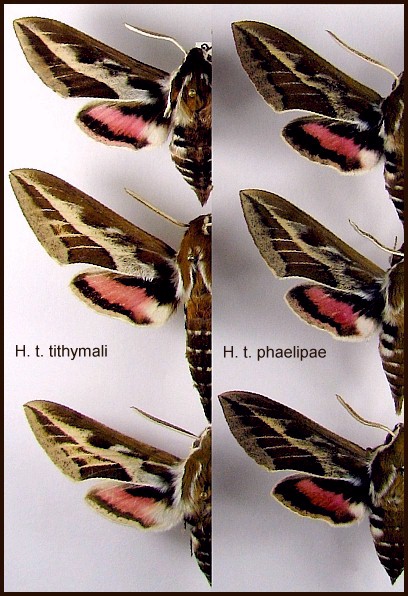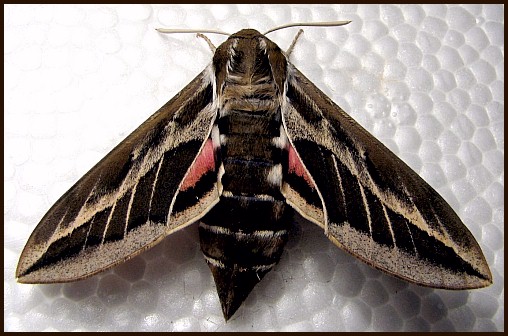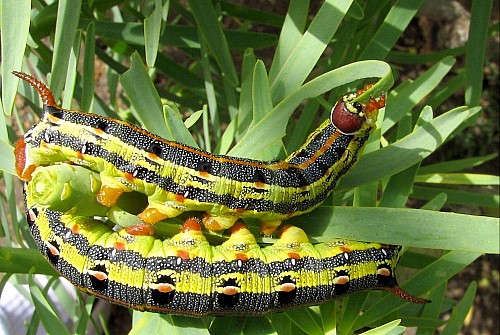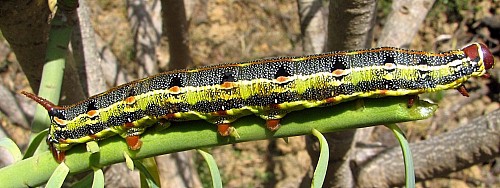UK: Barbary Spurge Hawkmoth, F: Sphinx du Tithymale
Hyles tithymali phaelipae Gil-T. & Gil-Uceda, 2012, Neue Entomologische Nachrichten 68: 294.
Type locality: 2km NE of Orchilla lighthouse, El Hierro, Canary Islands.
(Taxonomic notes. (i) Studies of both larvae and adults demonstrate that Hyles tithymali phaelipae is probably a good subspecies, on a par with Hyles tithymali gecki de Freina, 1991. However, how it arose is open to conjecture. It could have evolved in semi-isolation on the island of El Hierro and La Palma or, more likely, be a remnant of a previous pan-Canary Island population which has since been replaced on the other islands by a subsequent wave of colonization from North Africa (see Hundsdörfer, Kitching & Wink (2005a) for a possible explanation).
(ii) This subspecies was originally described in 2007; however, an anomaly in the description rendered this invalid -- there was no indication where the holotype was deposited. In accordance with what is stipulated in article 16.4.2 (Recommendation 16C) of the International Commission on Zoological Nomenclature, International Code of Zoological Nomenclature (1999), this mistake was rectified by an addendum published in 2012 (Gil-T. & Gil-Uceda, 2012).)
Holarctic; western Palaearctic region. Pleistocene refuge: Monocentric -- Canary Island subsection of the Mediterranean refuge. Part of the present day Macronesian faunal element.

Wingspan: 69--80mm. Similar in coloration and pattern to some individuals of Hyles tithymali gecki from Madeira.

An inhabitant of dry hillsides with a good growth of Euphorbia lamarckii and Euphorbia berthelotii.
So far as is known, February to October in a number of broods. May be continuous-brooded.
OVUM: Similar to that of Hyles tithymali tithymali (Boisduval, 1834).
LARVA: Full fed: 75--85mm. Freshly emerged larvae are green, but change very rapidly to a dark olive, then olive-black after feeding (Gil-T. & Gil-Uceda, 2007).
In the third instar the larval patterning starts to become noticeable and well defined. The dorso-lateral eye-spots begin to show some of their unique characteristics, i.e. elongated spots, initially white, turning ochre-orange after a few days (Gil-T. & Gil-Uceda, 2007).
The final colours and patterning appear in the fourth instar. A high percentage of larvae (>95%) have a pale greenish-yellow dorso-lateral stripe running through the dorso-lateral eye-spots, from head to horn. The black patch surrounding the eye-spots is thus split into an upper and lower crescent. It thus closely resembles certain forms of Hyles livornica (Esper, 1780). In all individuals the white eye-spots are flushed with ochre-orange (Gil-T. & Gil-Uceda, 2007).
In behaviour it is very similar to that of Hyles tithymali tithymali.
Occurs mainly from March to December.


Hostplant. The shrubby Euphorbia lamarckii [syn. Euphorbia broussonetii & Euphorbia obtusifolia]. Aslo Euphorbia berthelotii on La Gomera. (The latter is a member of the Euphorbia obtusifolia complex confined to La Gomera.)
PUPA: Morphologically indistinguishable from that of Hyles tithymali tithymali.
None recorded.
A relict subspecies confined to the islands of El Hierro and La Palma in the Canary Islands (Gil-T. & Gil-Uceda, 2007; Gil-T., 2010b). The population on La Gomera appears to the result of hybridization between this taxon and the more easterly Hyles tithymali tithymali from Tenerife, Gran Canaria, Fuerteventura and Lanzarote (Gil-T., 2010a).
Extra-limital range. None.
 Return to species list
Return to species list